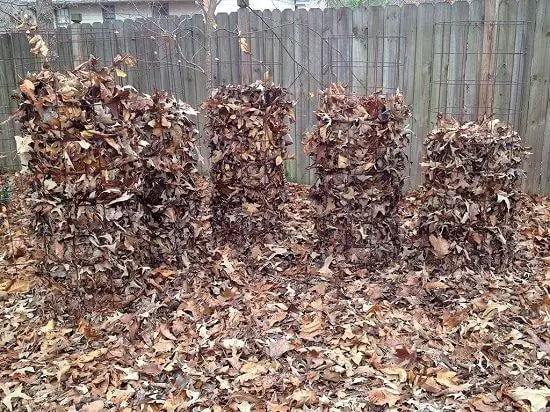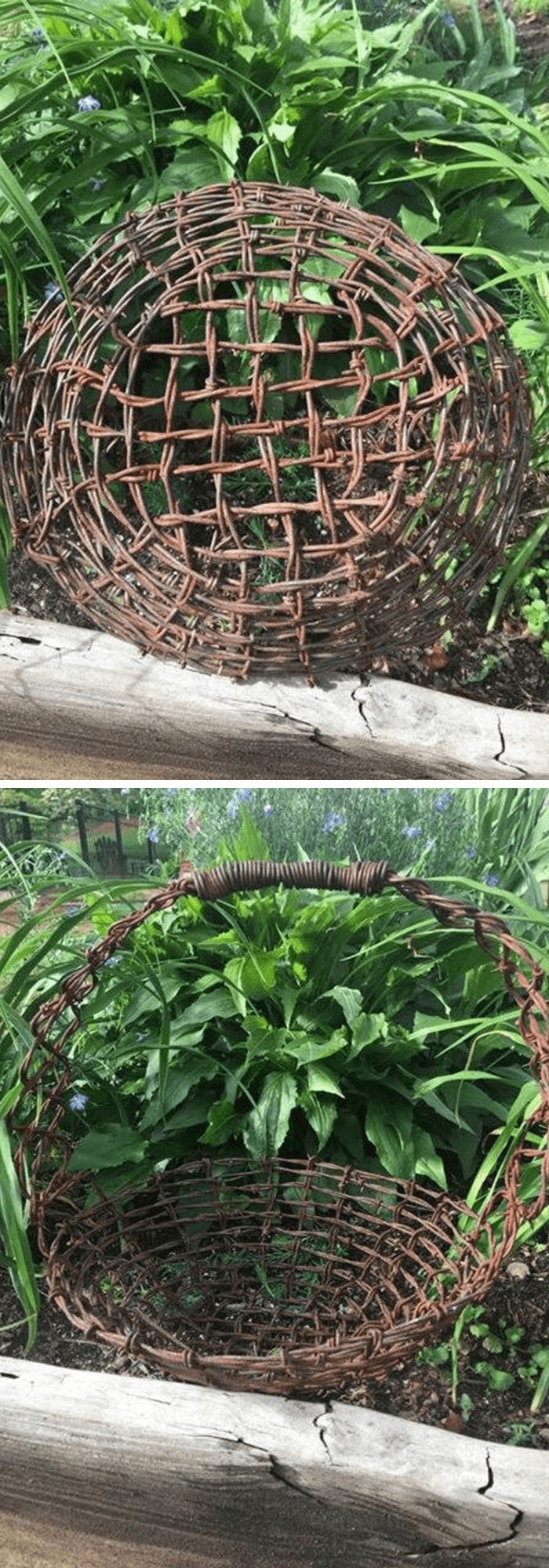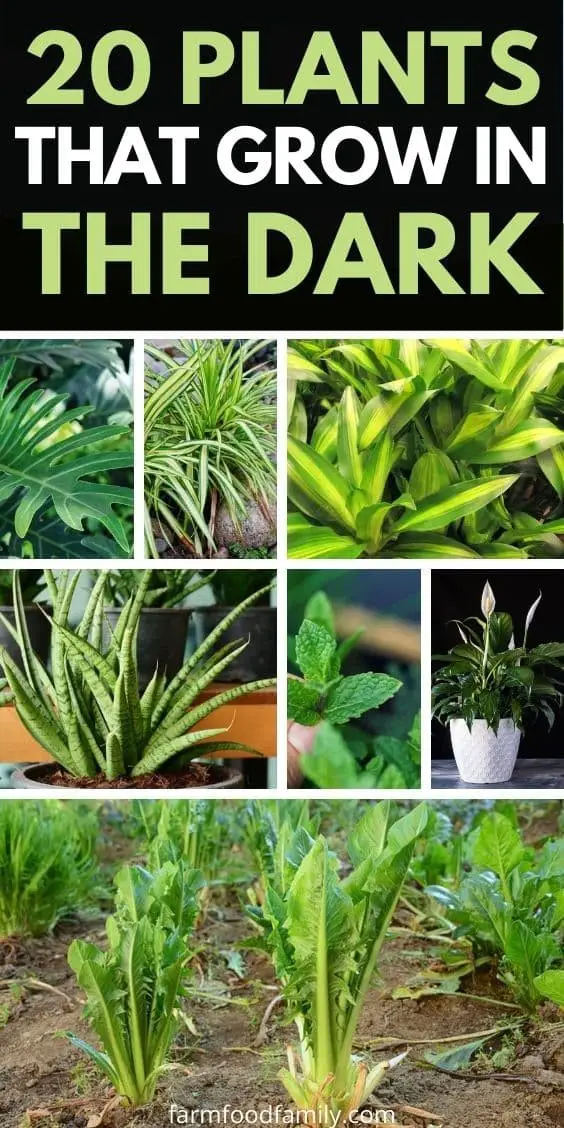17+ Types Of Redbud Trees With Their Leaves And Flowers
Rethinking the allure of redbud trees, it’s easy to get caught up in their whimsical charm. The sight of pink blooms bursting forth from sturdy trunks is a treat for the eyes. But there’s more to these trees than meets the eye – their heart-shaped leaves, which come in a range of colors, are just as captivating. As we delve into the world of redbud trees, you’ll discover a wealth of information about these enchanting plants.
From their varying types and characteristics to the best ways to care for them, this article aims to cover everything from start to finish. Redbud trees have a certain je ne sais quoi that makes them hard to resist. Their unique combination of striking foliage and vibrant flowers makes them a standout in any garden or landscape. With over 17 different types of redbud trees to explore, there’s bound to be one that catches your eye. Types of Redbud Trees:1.
Ace of Hearts (Cercis canadensis ‘Ace of Hearts’)2. Alba Redbud (Cercis siliquastrum ‘Alba’)3. Weeping Lavender Twist Redbud (Cercis canadensis ‘Covey’)4. Chinese Redbud (Cercis chinensis)5. Eastern Redbud (Cercis canadensis ‘Canadensis’)6. Forest Pansy (Cercis canadensis ‘Forest Pansy’)7. Hearts of Gold (Cercis canadensis ‘Hearts of Gold’)8. Judas tree (Cercis siliquastrum)9. Merlot (Cercis canadensis ‘Merlot’)10. Mexican Redbud (Cercis canadensis ‘Mexicana’)11.
Oklahoma Redbud (Cercis canadensis var. texensis ‘Oklahoma’)12. Ruby Falls (Cercis canadensis ‘Ruby Falls’)13. Silver Cloud Redbud (Cercis canadensis ‘Silver Cloud’)14. Texas Redbud (Cercis canadensis ‘Texensis’)15. Tennessee Pink Redbud (Cercis canadensis ‘Tennessee Pink’)16. The Rising Sun Redbud (Cercis canadensis ‘The Rising Sun’)17.
Western Redbud (Cercis occidentalis)In addition to exploring the various types of redbud trees, this article will also cover some pros and cons, as well as offer practical advice on caring for these beautiful plants.
What are the redbud trees?
The redbud tree is a deciduous member of the Fabaceae family, commonly referred to as the pea, bean, or legume family. Native to eastern North America, it can be found growing in states such as Florida and California, with Oklahoma proudly designating it its official state tree. The redbud’s small, pink blooms are a surefire sign of spring’s arrival, as they reliably burst forth at the season’s onset.
When not showcasing these vibrant flowers, the tree is notable for its dense canopies of heart-shaped leaves, which provide excellent shade. Additionally, various cultivars of the redbud tree offer a kaleidoscope of colors in their foliage, featuring hues ranging from red and burgundy to golden yellow, green, and orange. This visual spectacle is further enhanced by the small white or pink flowers that adorn the tree’s branches.
Where is the best place to plant a redbud tree?
In order to truly appreciate the vibrant flowers and foliage of a redbud tree, it’s essential to plant it in an area that receives full sun or dappled sunlight. A low-maintenance requirement, these trees thrive in well-draining soils and can tolerate a range of pH levels, including slightly acidic or alkaline conditions. Heavy clay soils are also suitable for redbuds, which makes them relatively easy to grow in many regions.
From a technical standpoint, redbud trees are hardy in USDA Zones 4-9, but they’re not limited to these areas alone. In fact, certain cultivars excel in the warm, sunny climates of southwestern states like Oklahoma, Texas, and Tennessee, while others flourish in Florida, California, Utah, and Arizona. Canada is also home to some robust redbud varieties.
Redbud leaves
Redbud leaves are a visual treat, boasting an array of colors within their heart-shaped forms. The leafy foliage emerges two to three weeks after the redbud flowers have bloomed, adding a new dimension to the tree’s overall aesthetic. As they grow, the leaves appear alternately along bare branches that stretch out or dangle elegantly.
A remarkable aspect of redbud leaves is their initial coloration, which can range from fiery red and maroon tones to apricot, chartreuse, blue-green, and even green hues. As autumn arrives, these leaves transform into vibrant shades of yellow and golden yellow, making the tree an attractive specimen for any landscape.
Redbud flowers
In home landscapes and urban settings, redbud trees are ideal accent trees due to their vibrant flowering displays. The showy blossoms, shaped like tiny peas, can create a dense canopy in shades of pink, purple, and magenta. Some varieties, such as the Texas white bud, produce an abundance of white blooms, while unique hybrids may yield a mix of white and pink flowers during the spring season. Interestingly, redbud trees often precede leaf unfurling with their blossoming phase.
Furthermore, the blooms typically emerge from brown pods, adding to the tree’s visual appeal.
Types of redbud trees
While there may be just nine recognized species of redbud trees, each one has its own unique variations through cultivation. This diversity is reflected in this list, which showcases some of the most popular redbud tree types and cultivars that are commonly used as accent and specimen plants in various landscape designs.
Ace of Hearts (Cercis canadensis ‘Ace of Hearts’)

A standout feature of this dwarf redbud variety is its striking, heart-shaped leaves that provide a unique aesthetic appeal. In stark contrast to its deep green foliage, the tree produces delicate pale pink-violet blooms that add an extra layer of visual interest.
As autumn arrives, the leaves transform into vibrant shades of yellow, making it a highly sought-after specimen tree due to its exceptional hardiness and natural resistance to disease and pests, which eliminates the need for frequent maintenance or treatment.
Alba Redbud (Cercis siliquastrum ‘Alba’)
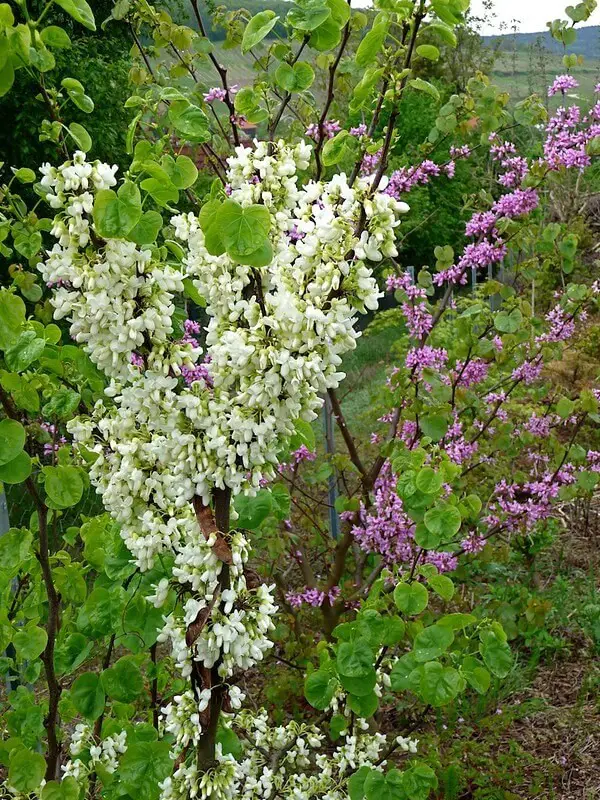
The redbud tree, also affectionately referred to as the white bud, earns its name from the dainty white flowers that bloom in the spring. Following this fleeting floral display, the tree’s bronze heart-shaped leaves emerge and take center stage. As the seasons progress, these leaves transform from green in the summer to a vibrant yellow during the fall. One of the most low-maintenance varieties of redbud trees, its adaptability makes it a popular choice among gardeners.
Weeping Lavender Twist Redbud (Cercis canadensis ‘Covey’)

The Eastern Redbud cultivar known as ‘Covey’ is a dwarf variety that grows to an impressive 10ft in height. This compact tree is perfect for small gardens, offering a unique charm reminiscent of Japanese maples at maturity. Its standout features include heart-shaped green leaves and clusters of pink-lavender flowers bursting forth during springtime. Notably, the ‘Covey’ also boasts twisting branches, earning it the nickname ‘Lavender Twist’.
Chinese Redbud (Cercis chinensis)

The Cercis canadensis ‘Forest Pansy’ is renowned for its remarkable reputation, boasting an impressive display of purple-pink flowers throughout the entire spring season. This variety stands out from others due to its striking large, heart-shaped leaves, which begin as a deep green hue with subtle red undertones before transitioning to a pale yellow during fall.
Eastern Redbud (Cercis canadensis ‘Canadensis’)
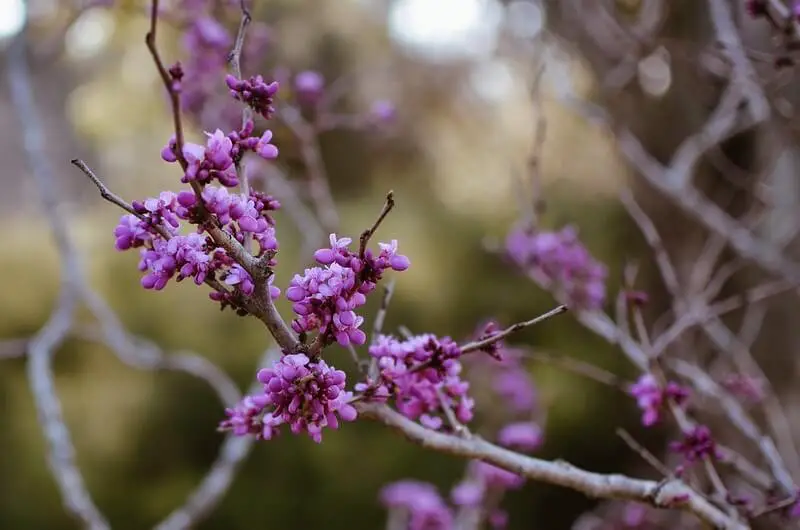
The Eastern Red Cedar (Juniperus virginiana) has a unique charm that resonates across North America, with its native range extending into Ontario and other parts of Canada. Interestingly, it’s also the official state tree of Oklahoma.
This majestic tree boasts a commanding presence, characterized by multiple trunks, vibrant flowers blooming in various shades of pink, brown pods where the blooms unfold, and striking foliage that transforms from lime green-red hues in summer to deep green and yellow during fall. Its allure extends beyond its aesthetic appeal, as it’s a haven for butterflies and bees. Moreover, it’s surprisingly low-maintenance and exhibits natural resistance to disease and pests.
Forest Pansy (Cercis canadensis ‘Forest Pansy’)
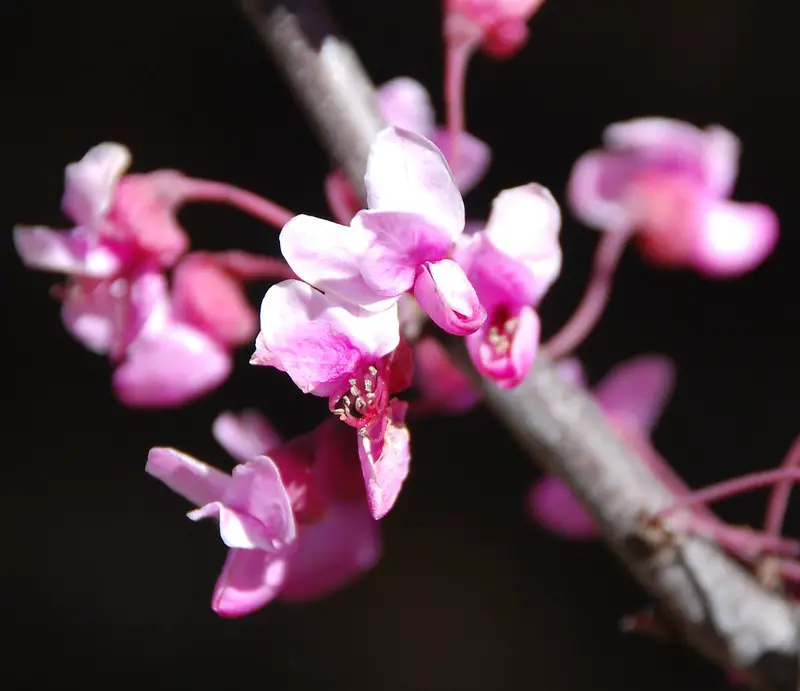
The eastern redbud boasts one of its most striking features in its vibrant red and purple foliage, which remains stunning throughout the summer months. As autumn approaches, this colorful display gives way to an equally impressive show of burgundy flowers with subtle green undertones. The tree’s diminutive pink blooms perfectly harmonize with its striking foliage, making it a highly sought-after choice for landscape designs – particularly among enthusiasts of the eastern redbud cultivar.
Hearts of Gold (Cercis canadensis ‘Hearts of Gold’)

The ‘Goldmound’ redbud is a unique cultivar that earns its name from the distinctive coloration of its leaves. As they unfurl, they begin as gold-colored and gradually transition to a vibrant chartreuse hue. One of the standout features of this variety is the exceptional glossiness of its leaves, which seem to shine in the sunlight. In addition to their striking appearance, the ‘Goldmound’ redbud’s leaves are also notable for their burn-resistance.
Before the foliage emerges, the tree produces an impressive display of purple/lavender flowers, adding to its visual appeal.
Judas tree (Cercis siliquastrum)

The Mediterranean redbud, characterized by its vibrant blooms and lush foliage, is a regional treasure. During spring, this tree produces an impressive display of old rose-pink flowers that form a dense dome canopy. What sets it apart from other redbuds is the size of its blossoms – they’re significantly larger than typical redbud blooms.
Following the blooming period, the tree’s foliage emerges, initially showcasing copper-red hues before maturing into deep green during summer and transitioning to pale yellow in autumn.
Merlot (Cercis canadensis ‘Merlot’)

The result of combining Forest Pansy and Texas Redbud is a unique hybrid that boasts a distinctive charm. Its leaves, characterized by their thick and glossy texture, display a rich color reminiscent of Merlot wine. The addition of magenta and pink flowers on leafless branches during spring adds an extra layer of visual appeal, making this plant a perfect choice for those seeking to create a vintage-inspired garden.
Mexican Redbud (Cercis canadensis ‘Mexicana’)

While the Texas redbud may be larger, this drought-tolerant variety holds its own with its compact stature. Its distinguishing feature is its glossy, wavy leaves that are a vibrant blue-green color. These leaves emerge after the plant has finished blooming its striking violet flowers in the spring. The multi-stemmed habit adds to the shrub’s charm, making it an attractive addition to any landscape.
Oklahoma Redbud (Cercis canadensis var. texensis ‘Oklahoma’)

The ‘Compact Redbud’ is a standout among accent redbuds due to its diminutive stature and vibrant displays of purple-red flowers, which persist until summer’s warmth subsides. The tree’s crowning glory, however, lies in its foliage: heart-shaped leaves with a glossy sheen radiate sunlight with an intensity that rivals the brightest gemstones.
As autumn’s hues unfold, these same leaves transition to a warm brown-yellow hue, providing a striking backdrop for the tree’s already impressive visual appeal.
Ruby Falls (Cercis canadensis ‘Ruby Falls’)

What sets this particular variety apart is its unique combination of compact growth and weeping habit, creating a visually striking canopy. As a bonus, it’s well-suited for smaller gardens, reaching a modest height of just 6 feet. In early spring, vibrant red-purple flowers burst forth in a stunning display, contrasting beautifully with the maroon-green leaves that remain.
Silver Cloud Redbud (Cercis canadensis ‘Silver Cloud’)

The variegated redbud is distinguished by its singular trunk and more sparse foliage and blooms, yet it still boasts a striking presence. The fuschia- silver flowers are particularly eye-catching, while the green leaves feature a glossy sheen and prominent white edges. This ornamental tree has garnered widespread popularity over the years.
Texas Redbud (Cercis canadensis ‘Texensis’)

The Texas White Redbud is a unique species native to Texas and Oklahoma. Characterized by its magnolia-like form with a coarser texture, this tree produces small, white blooms that set it apart from other redbuds. Its deep green leaves take on a vibrant yellow hue in the fall, making it an attractive addition to lawns or urban landscapes.
Tennessee Pink Redbud (Cercis canadensis ‘Tennessee Pink’)

One of the most charming features of this dwarf redbud is its compact size, reaching only 12 feet tall. This makes it an excellent choice for container gardening, as well as a popular specimen tree in landscapes. As the seasons change, this deciduous shrub puts on a delightful display. In the spring, it produces clusters of small, pink flowers that signal the start of new growth. The green foliage unfurls shortly after, providing a lush backdrop for the remaining blooms to fade.
As autumn arrives, the leaves turn a soft yellow hue before dropping off, revealing a statuesque silhouette that’s as unique as it is regal.
The Rising Sun Redbud (Cercis canadensis ‘The Rising Sun’)

The Rising Sun plant stands out as a stunning landscape centerpiece due to its vibrant displays of color throughout the seasons. In early spring, it produces an abundance of lavender flowers that create a beautiful focal point. Additionally, its apricot-colored heart-shaped leaves undergo a transformation during this time, transitioning from their initial hue to a warm orange tone. As fall arrives, these same leaves shift again, taking on a golden yellow color.
What’s particularly striking about the Rising Sun is that it often achieves a dazzling trifecta of colors – orange, gold, and yellow – all present at once, hence its name.
Western Redbud (Cercis occidentalis)

A southwestern USA native, this ornamental tree boasts a unique appeal that’s cherished by many. Its impressive display of blooming clusters in early spring is a treat to behold, with purple flowers adding a pop of color to the landscape. As the seasons change, its foliage transitions from pale green to deep green, showcasing the beauty of growth and development.
A haven for pollinators like bees, butterflies, and hummingbirds, this tree has earned a reputation as a popular choice for garden accents, offering a feast of nectar-rich blooms that attract these tiny visitors.
Pros and cons of redbud trees
While redbud trees are often praised for their beauty and ease of care, they may not be suitable for every landscape. To provide a balanced view, let’s weigh the pros and cons of this deciduous tree.
On one hand, redbuds are known for their drought resistance, low maintenance requirements, and disease/pest resistance. They also boast a vibrant bloom display from spring to mid-summer, making them a popular choice for accent or specimen trees in various landscapes.
Furthermore, they offer high ornamental value.
However, there are some drawbacks to consider. For example, redbuds can become weedy at the base if not properly pruned, and they do require regular pruning annually to maintain their shape. Additionally, occasional diseases can be fatal since the tree is sensitive to herbicides. Lastly, redbuds have a slow growth rate and do not live for many years, which may be a consideration for those looking for a long-term landscape solution.
Caring for a redbud tree

To ensure your redbud tree flourishes in its new home, it’s essential to understand its unique needs beyond its reputation as a low-maintenance and adaptable deciduous tree. By considering these specific care requirements, you’ll be able to provide the ideal environment for your redbud tree to thrive. Let’s dive into the specifics of how to care for this lovely tree.
Location
When it comes to Redbud care, one crucial aspect to consider is their tolerance for water. Surprisingly, these trees don’t thrive in excessively wet conditions – instead, they prefer moderate moisture levels. To support their growth, ensure they receive direct sunlight daily and plant them away from water sources to prevent root rot or other issues.
Watering
As the redbud tree’s roots become established, you can gradually adjust your watering schedule. While these trees are surprisingly drought-tolerant, occasional hydration during dry spells will still promote healthy growth. During spring and fall when moisture is more plentiful, you can space out waterings to every two to three weeks. However, if the weather becomes particularly arid, a weekly soaker should suffice.
Fertilizer
For optimal development, redbud trees benefit from annual fertilization, with the best time being early spring. When selecting a fertilizer, opt for a slow-release formula designed specifically for your redbud tree’s unique needs.
Pruning
While redbuds don’t typically require pruning, maintaining their shape and density necessitates occasional trimming. When deciding to prune, it’s best to do so after the blooming period has ended. This allows for the removal of any dying or dead branches before new leaves emerge, ensuring a healthy canopy. Winter pruning is not recommended, as it can lead to reduced blooms in subsequent springs.
Additionally, redbuds may be susceptible to certain insects and diseases, which are an integral part of overall tree care. It’s essential to be aware of these potential issues and take proactive measures to address them.
Pests/insects
Treehoppers are known to lay their eggs under the branches of redbud trees, although it’s not a significant issue. However, they do produce sticky foam that can accumulate on the branches and create an overabundance of moisture, which can weaken the tree’s twigs and branches.
Spider mites are another common issue that affects redbud trees. They cause speckled leaves, typically found on the undersides of the foliage, as well as abnormal curling and early leaf discoloration.
Scales are a more significant problem for redbud trees. These tiny insects create waxy lumps along the tree’s bark, which can lead to yellowing leaves or premature dropping of foliage.
Diseases
Cankers, leaf spots, and verticillium wilt are some of the most detrimental diseases affecting redbud trees and numerous other shrubs and trees. The onset of cankers is often marked by wilting leaves or foliage dropping, while leaf spots are characterized by black lesions on the undersides of leaves, potentially leading to early defoliation. In contrast, verticillium wilt is a more insidious threat, caused by fungi that can spread through excessive moisture and contaminated pruning equipment.
Initial signs include yellowing or browning leaves, followed by the emergence of stunted, yellow new growth and eventual decline. While reputable herbicides may offer some relief from these diseases, it’s crucial to recognize that redbuds are inherently sensitive to such chemicals, which can hasten their demise rather than rescue them. To effectively combat these diseases and insect infestations, adhering to proper care guidelines is essential.
Frequently Asked Questions
Before diving into the world of planting redbud seedlings, it’s essential to familiarize yourself with some key facts and answers to common questions. This will help ensure a successful and enjoyable experience. As we’ve already touched on the basics, let’s delve deeper into the specifics that’ll make your endeavors truly thrive.
How fast do redbud trees grow?
Redbuds are characterized by their moderate pace of growth, with an average rate that’s neither exceptionally rapid nor alarmingly sluggish. While these trees can reach a mature height of 7-10 feet within a span of 5-6 years, their slow growth rate is often viewed as one of the drawbacks of cultivating redbuds, particularly given their relatively short lifespan.
How tall does a redbud tree get?
Redbud trees typically attain a height of 20-30 feet, with some varieties reaching an impressive spread of up to 35 feet as they mature. However, certain cultivars are bred to be more compact and may only reach 10-12 feet in height, while dwarf types and cultivars can grow as short as 4-8 feet, making them a great option for smaller spaces or gardeners who prefer a more manageable plant.
What is the life expectancy of a redbud tree?
While individual redbud tree lifespans can vary depending on factors such as species and environmental conditions, most are considered deciduous with average lifespans ranging from 20 to 40 years. However, eastern and western varieties exhibit distinct differences in longevity. The native western redbuds of California, Utah, Arizona, and Nevada are reported to have a longer lifespan, spanning 50 to 75 years. One critical factor influencing redbud tree longevity is the impact of transplanting.
Once planted, young seedlings can be sensitive to disturbance, and repeated transplanting or unfavorable growing conditions can significantly shorten their lifespan.
Are redbud tree roots invasive?
While opinions may vary on the invasiveness of redbud tree roots, the general consensus is that they are non-invasive due to their shallow root system. However, this doesn’t mean that redbud trees don’t require careful consideration when it comes to planting distance from structures like homes. In fact, the taproot of a redbud tree tends to spread out at roughly the same rate as its canopy, which can be up to 25 feet in diameter for some varieties.
As such, it’s generally recommended that redbud trees be planted at least 25 feet away from a home’s foundation to minimize any potential damage caused by root expansion. Although the roots themselves may not be as thick or extensive as those of other deciduous trees, there is still a risk of disruption to the home’s foundation if not properly spaced.
What can I plant under a redbud tree?
Redbud trees, like dogwoods, thrive in understory roles, providing a lush canopy beneath taller hardwoods in forest floors. Their striking blooms are already a sight to behold, but pairing them with other flowering plants can create an even more breathtaking display in your garden. For contrast, Queen of the Night tulips can complement redbud’s lighter hues, while Pink Diamond tulips match fuchsia or magenta-colored redbud blooms.
If your redbud basks in full sunlight, phlox or money plant make perfect accents. Other understory-friendly plants to consider are wax mallow, Desert honeysuckle, Texas sedge, Sandy sedge, Blood sage, Daisies, American beautyberry, Canada wildrye, and Texas sacahuista. These low-impact additions won’t disturb the redbud’s sensitive root system, even its shallow roots, making them ideal companions for your garden.
Conclusion
Redbud trees are undoubtedly remarkable, boasting a stunning display of color and blooms every spring. Their year-round appeal is undeniable, whether their branches are bare or their foliage has changed with the seasons. However, it’s essential to acknowledge that they also have some drawbacks – their relatively short lifespan being one notable consideration.
Despite this, redbud trees remain highly prized as ornamental and specimen trees.
They thrive in urban settings like parks and national reserves, and also make excellent accent trees for small home landscapes and lawns.
Ultimately, redbuds are commendable choices for any landscape. To truly appreciate their value, it’s crucial to delve deeper than what initially meets the eye.
Related Posts
Discover the vast array of plants available at an online nursery, from apple trees to evergreens. For those looking to turn their passion into a career, learn how to become an arborist with our comprehensive guide. Moreover, understand the significant impact that trees can have on a property’s value and ambiance. While trees can greatly enhance your home’s appeal, sometimes removing them is necessary.
Explore the care and growing tips for the lady palm (Rhapis excelsa), a popular choice among plant enthusiasts. If you’re looking to grow organic blueberry plants in your garden, we’ve got you covered with expert advice.

